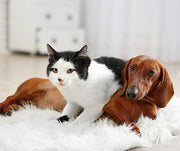Enjoy 20% OFF full-price travel & kennel must-haves with code THANKFUL20 at checkout!
Promo ends 11/21 at Midnight CST. Cannot be combined with other discounts.
Preparing Pets for Back to School

The return to school isn't just a big deal for the humans in the family. It's a big moment on the calendar for the pets in the family too. That's because our pets get used to our routines, and summer vacation typically means that the family is around the home more, especially since the start of the pandemic. Dogs are particularly sensitive to change in routine and can experience separation anxiety as a result in the change of the family's schedule. Below is an explanation of separation anxiety and tips to help you soothe your pet as school starts up again.
What is Separation Anxiety?
In essence, pets experience separation anxiety when they can't handle being on their own or apart from their families. Dogs can feel this anxiety acutely when their owners leave home for the day. For cats, anxiety can set in if their owners are gone for several days.
What Does Separation Anxiety Look like in Pets?
Dogs with separation anxiety tend to act out by whining, crying, urinating inappropriately, chewing, and pacing. These behaviors can last for a few hours during the separation or during the separation in its entirety. They might also follow their owners from room to room, closely attached to them while they are still at home. Dogs between 18 months to 3 years of age are particularly susceptible to sudden changes in routine and schedule.
Cats can exhibit similar behaviors, urinating and defecating outside the litter box. They can also vocalize excessively, groom, and destroy things. Separation anxiety is more common in female cats and cats that live indoors. Another contributing factor is when the animal is without the companionship of another animal or has experienced the sudden loss of a companion animal or human.
How You Can Ease Your Pet's Separation Anxiety
For boths dogs and cats, experts recommend trying to provide enrichment activities. For dogs, this means providing a wide array of chew and treat toys, so that they are not so reliant on their owners for entertainment. Experts also recommend helping dogs get acclimated to their owners' absence by limiting attention paid in the hour before leaving for the day. Much of the same goes for the half hour after owners arrive home from being out for the day.
Another option is for owners to build in absences gradually, leaving the home for a few hours at a time without their dogs. Limiting attention, while hard to do, will help dogs become accustomed to the idea that their owners are not always accessible. Consistent exercise and a balanced diet help alleviate anxiety too. Paying for a doggy daycare is an option for providing dogs with companionship.
For cats, providing a wide variety of toys is also an important strategy to keep them occupied. Because cats like to hunt for their food, puzzle feeders, which are toys that cats have to play with to access food inside, are a great way to keep them engaged. Experts recommend that owners pay attention to their cats when the cats are calm and acting in a self-sufficient manner. If they are meowing often and crying for attention, it's best to ignore them until the behavior has subsided.
Conclusion
Separation anxiety is a normal emotional response to pets' being home alone. There are care measures that pet owners can take to help their pets become gradually more accustomed to being alone at home for longer stretches during the day. With the lifting of covid restrictions and the approaching return to school, now is a good time to address your pet's separation anxiety.
Additional Resources:
- https://source.colostate.edu/pet-health-back-to-school-time-can-trigger-separation-anxiety-in-pets/
- https://www.petmd.com/cat/conditions/behavioral/can-cats-have-separation-anxiety
- https://abc7chicago.com/separation-anxiety-pets-symptoms-back-to-school/10667641/
- https://www.cascadekennels.com/tips-back-school-work-separation-anxiety-pet/
Previous article

Next article

Related posts
View all-

How to Keep Your Pet Calm During Thanksgiving
Thanksgiving is a time for family, friends, and food, but for our pets, the holiday can be overwhelming. The sudden change in routine, unfamiliar faces and scents, and increased noise can trigger significant stress. Understanding why your pet might feel anxious is the first step toward creating a peaceful holiday experience for everyone, including your furry family members. This guide offers calming tips for pets and practical solutions to ensure your dog or cat feels safe and secure during the festivities.
Read Article -

Top Travel Essentials for Pets This Holiday Season
Holiday travel often means bringing the whole family along, and for many of us, that includes our furry companions. Preparing for holiday pet travel is about more than just packing a bag; it's about ensuring your pet's safety, comfort, and happiness from the moment you leave home until you return. A little planning helps reduce stress for both you and your pet, making the journey a positive experience for everyone involved.
Read Article -

Best Leashes and Collars for Daily Walks: A Pet Parent’s Guide
A daily walk with your dog isn't just a chore—it's a chance to bond, explore, and stay active together. The right leash and collar can make every walk safer and more enjoyable for both of you. With numerous styles and materials available, it's essential to find gear that suits your dog's needs and your lifestyle.
Read Article



